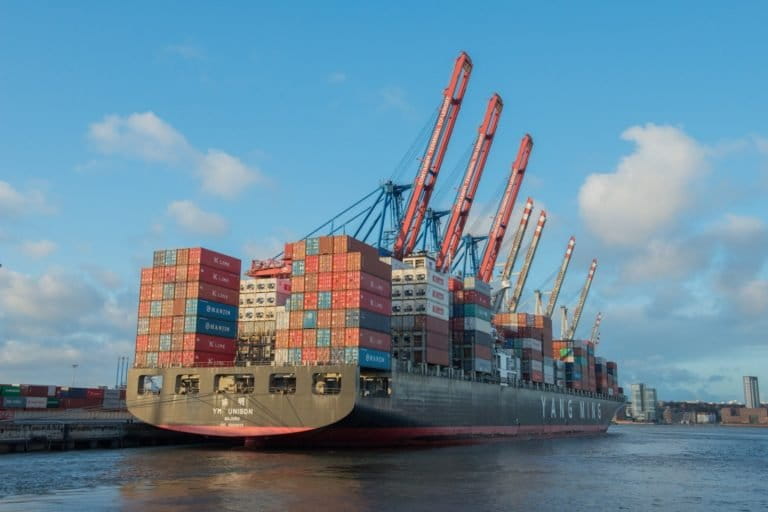New age of sail looks to slash massive maritime carbon emissions

Despite the present dominance of fossil-fueled cargo ships, it’s well understood by industry insiders that the current maritime logistics system is both aging and fragile.
Fossil fuel transport today is up against a grim carbon reality: if ocean shipping were a country, it would be the sixth-largest carbon emitter, releasing more CO2 annually than Germany. International shipping accounts for about 2.2% of all global greenhouse gas emissions, according to the U.N. International Maritime Organization’s most recent data.
This annual surge of atmospheric carbon released by ocean going ships not only worsens climate change — one of nine scientifically defined planetary boundaries (PBs) we now risk overshooting — it also contributes to ocean acidification (a second planetary boundary) which is beginning to seriously impact biodiversity (a third PB). And add to that significant chemical pollution (a fourth planetary boundary) that is emitted from ship smokestacks.
All of these planetary boundaries interrelate and influence one another (negatively and positively): for example, reducing black carbon (or soot), the fine particulate matter emitted from fossil fueled oceangoing vessels could slow global warming somewhat, buying time to implement further steps to reduce carbon emissions.

Another problem with today’s vessels: when cargo ships dock, they use auxiliary engines that generate SOx, NOx, CO2 and particulate discharges, while also creating noxious noise and vibrations. (Innovators are already solving this problem with cold ironing, providing shoreside electrical power to ship berths, allowing main and auxiliary engines to be shut down.)
Today’s cargo industry is plagued not only by environmental issues, but by a difficult logistical and economic problem: its current fleet of fossil-fueled container ships are mostly behemoths — with immense carrying capacities. However, the “overcapacity” of these giant ships leaves them without the nimbleness to adapt to unexpected shifts in global supply and demand; the world’s ports and specialized markets could likely be better served, say experts, by smaller, far more fuel-efficient cargo ships.
The current sea cargo system — reliant upon high-priced carbon-based fuels and unstable energy markets; interwoven inextricably into long-distance, globalized world trade; and designed for just-in-time delivery that requires precisely scheduled shipments — is increasingly vulnerable to the vagaries of fossil fuel shortages, price shocks and surges, as well as geopolitical conflict and volatility in the Middle East, Venezuela and elsewhere.
Equally problematic, today’s fossil-fueled ships depend upon an ability to avoid paying for negative externalities such as carbon emissions and environmental pollution, while also being governed by lax international labor, environmental, health, and other agreements.
Winds of change, especially triggered by new international commerce and climate pacts and policies, could soon push us rapidly beyond carbon into a New Age of Sail, with the need for a planet-wide cargo fleet rebuilt from the keel up.
Birth pangs for a New Era of Sail
As far back as the 1970s, the global shipping industry began struggling with both its business models and environmental issues. Oil embargoes in 1973-74, the failure of US Lines in 1986, and surging fuel prices in the 1970s and ’80s led some transport companies to start experimenting with sail-assisted technology on tankers and container ships to save costs and reduce emissions. By the 1980s, Japanese shippers had designed new and retrofitted sail-assisted merchant ships.https://www.youtube.com/embed/U250mCuxPPw
In 2018, in response to environmental concerns, the International Maritime Organization (IMO) adopted mandatory measures under an umbrella of policies to reduce greenhouse gas emissions produced by international shipping: under the IMO’s pollution prevention treaty (MARPOL); the Energy Efficiency Design Index (EEDI), which is mandatory for new ships; and the Ship Energy Efficiency Management Plan (SEEMP). Many of these mandated changes go into effect by 2030, less than 10 years from now.
An embrace of old technologies, made new
Facing these many challenges, the big question for the cargo industry is: how does it get to a new age of post-carbon shipping and sailing, with the least amount of economic pain?
In fact, change is happening now — fast — as sailing vessels get put on the water by startup companies, like Fair Transport, with its retrofit wooden vessels; by modest sized proof-of-concept companies like the Schooner Apollonia; and by firms with newly built ocean-crossing sailing ships like Grain de Sail; and lastly by large cargo ship companies launching innovative retrofits and purpose-built vessels like Neoline’s new large cargo vessels.
All of these innovators embrace different technological approaches to address the same problems of CO2 emissions, the high cost of fossil fuels, and new global economic and regulatory realities.
Wind propulsion systems cover a wide spectrum in modern commercial shipping,. These range from wind-assisted fossil-fueled vessels (where wind provides auxiliary power), to purely wind-driven ships without auxiliary power, to sailing-hybrid ships where the primary propulsion come from the wind but is augmented by engines to ensure schedules are maintained.
Ceiba-Sail Cargo Inc. transports freight using a sustainable carbon-neutral sailing system. Its first ship, CEIBA, will offer something special to exporters and importers: an eco-friendly means of moving their most important organic, sustainable products.
The Hawila Project also offers an environmentally friendly way of shipping organic goods between small coastal communities, especially European producers. The vessel can transport 55 tons of cargo using only wind power.
Grain de Sail combines the best of old and new. It is a freshly built 24-meter (80-foot), 35-ton-capacity schooner with a state-of-the-art climate- and stability-controlled hull for maintaining fragile goods. Sail powered, it is equipped with cutting-edge navigation technologies and made out of aluminum for a better weight/performance ratio and greater durability. In December 2020, Grain de Sail unloaded a shipment of wine and cognac at the Brooklyn Navy Yard, becoming the first ocean-crossing sail cargo ship to unload cargo in New York since the schooner Black Seal delivered cocoa beans by sail to Mast Brothers chocolate makers in 2011.
Of these startups and proof-of-concept vessels, Jorne Langelaan, a veteran of Fair Transport’s sail cargo venture, may possess the boldest old-new sailing concept. Ecoclipper, when built, will be a big new “square rigger” and full-sized replica of the Dutch cargo ship Noach, built in 1857 — with an equally big mission. “She is to be operated in the deep-sea trade: Trans-Atlantic, Trans-Pacific and around the world,” says her promoter. She’ll be rigged with three square-rigged masts, boasting 930 square meters (10,000 square feet) of sail, “traveling without mechanical propulsion,” and able to transport up to 500 gross register tonnage (GRT) of cargo.

High-tech innovations
Maybe among the most unique innovations in the cargo shipping sector today are sails that look less and less like traditional sails. Known as sail-assisted or wind-assisted propulsion devices, the concept often is to fit existing fossil-fueled vessels with a variety of new sail technologies that offer a boost in power while cutting carbon emissions.
These cutting-edge approaches include wing sails, which are inflatable; “hard sails” which look like an airplane wing set up vertically; “Flettner” vertical rotor sails that resemble smokestacks (but which use the Magnus effect, a force acting on a spinning body in a moving airstream); the Dynarig, “a state-of-the-art, modern, high-tech rig, relying on the use of cutting edge, high-strength materials currently used on high-performance racing yachts”; and sail-assist kites or sky sails that look and act like hang gliders, launched from a ship’s bow with a cable to help pull the vessel downwind.
Neoline is a company capitalizing on new sail technology it says is “immediately available and [a] powerful enough solution to propel cargo ships.” The firm is already finding its eco-niche, establishing shipping contracts with tiremaker Michelin and automaker Renault, along with other companies looking to reduce their carbon footprint. The Viking Grace ferry, which sails the Baltic Sea, is equipped with Norsepower’s Flettner rotor sail, which provides clean, auxiliary power. Wallenius Marine is developing the Oceanbird, able to ship 7,000 cars and trucks across the Atlantic propelled only by high-tech wing sails.
These and other innovators have joined together in the International Windship Alliance, a gathering of new technology companies, ship builders, and shippers of all sizes who are changing the face of ocean shipping, replacing smoky fossil-fueled “dinosaurs” with nimble, “back to the future” sailing, sail assist, solar, electric and alternative fuel vessels.
To learn more about the New Age of Sail, look into Jan Lundberg’s Sail Transport Network, Dmitry Orlov’s insightful writings, Gavin Allwright and the International Windship Association, Madadh MacLAine and the Zero Emissions Ship Technology Association, and Di Gilpin’s Smart Green Shipping.
The New Age of Sail isn’t only evolving on the high seas: Lane Briggs’ Tugantine, Erik Andrus and Vermont Sail Freight, and Maine Sail Freight, are all forerunners of an epochal change underway in the way goods and people are moved along inland rivers and in coastal waters in a post-carbon era.
As fossil fuels grow scarce and expensive, sailing ships and alternatively powered vessels will replace fossil-fueled shipping, and the new ideas are seemingly endless: hemp and other cellulose-based plastics can replace fiberglass and other synthetic hull and sail materials; ships will ride above the waves on hydrofoils, maybe replacing airline high-speed passenger service; and many more small river, estuary and ocean ports will be renovated and updated to create an “internet” of coastal and island-linked small- to mid-sized shipping lanes.
New vessels will also require a different type of port: electric and people-powered first- and last-mile logistics, with old skills of seafaring, ship-keeping, and shipbuilding preserved, renewed and intermixed with 21st century know-how.
We are fast entering a world of sail, battery, and hydrogen; cargo shipping beyond carbon.
Before he died in 1947, Gustaf Erikson, who ran a fleet of Baltic Sea windjammers in the Åland Islands, “was fond of telling anyone who would listen that a new golden age for sailing ships was on the horizon: sooner or later, he insisted, the world’s supply of coal and oil would run out, steam and diesel engines would become so many lumps of metal fit only for salvage, and those who still knew how to haul freight across the ocean with only the wind for power would have the seas, and the world’s cargoes, all to themselves.”
That imagined day has nearly arrived.
Andrew Willner is a former boatbuilder, sailing vessel master, and retired NY-NJ Baykeeper, who in 2013-14 was recruited as a volunteer aboard the Vermont Sail Freight sailing barge Ceres built by Erik Andrus in his Vermont barn. The Ceres made two successful voyages from Burlington on Lake Champlain, traveling down the Hudson River to New York City with a shelf-stable cargo of high-value farm products, sold at pop-up markets at ports along the way and at the New Amsterdam Market final destination. Willner is also executive director of the Center for Post Carbon Logistics.
Source: Mongabay
Related Posts


